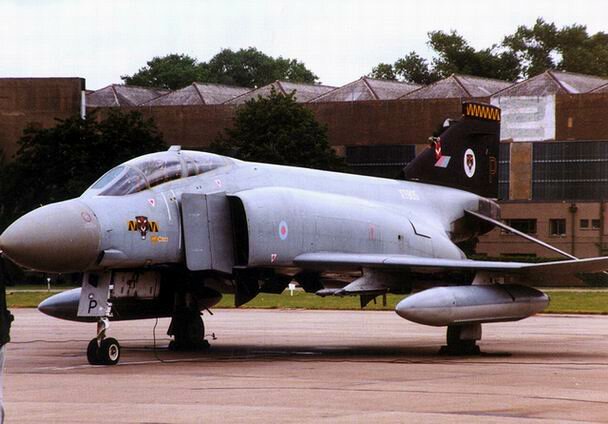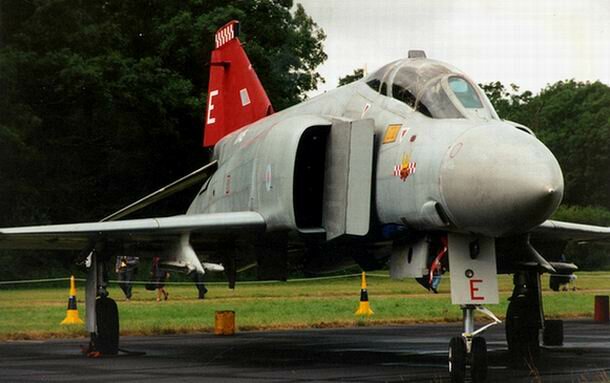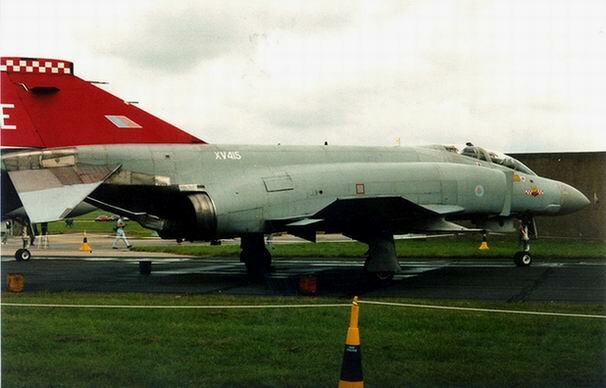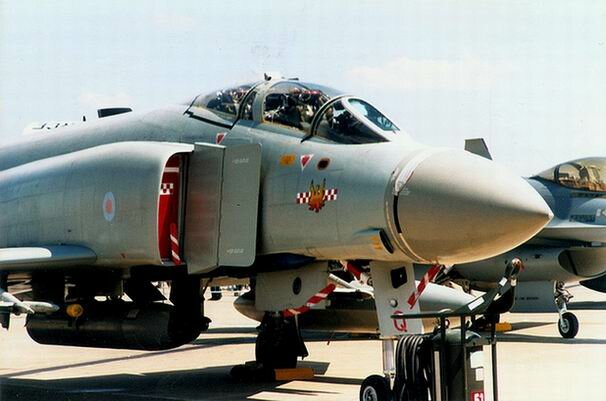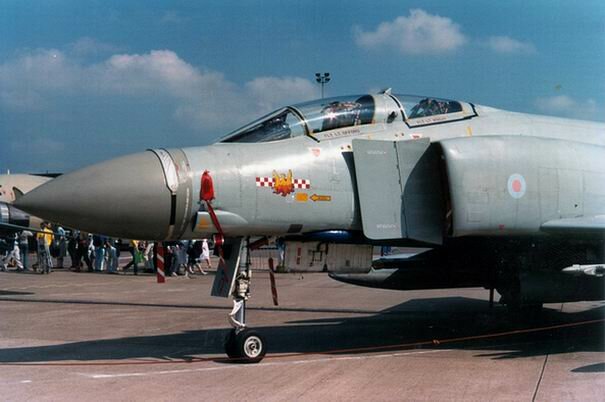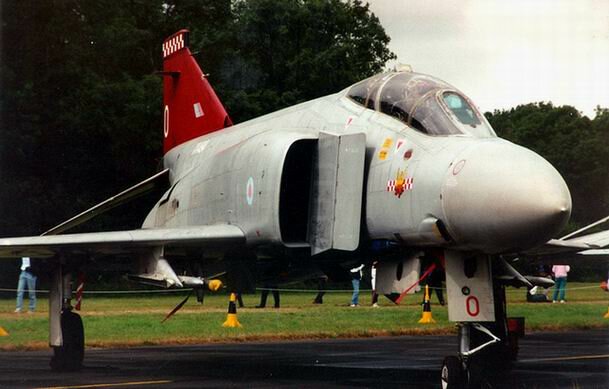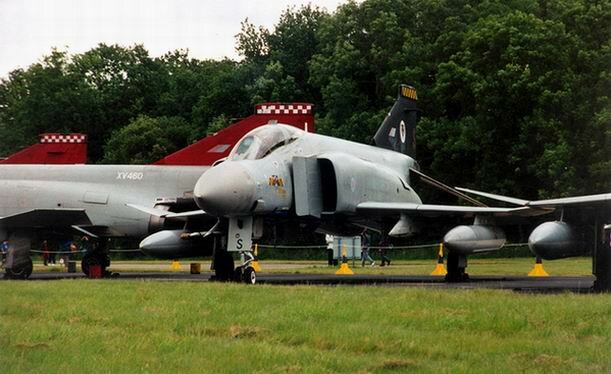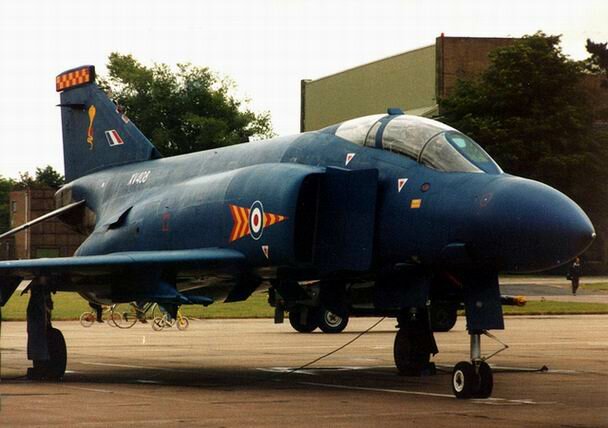|
From ACIG.org ACIG Database
The first British interest in the F-4 came from two different requirements of the armed forces: - the Royal Navy was searching for a two-seat carrier borne fighter to replace the Sea Vixen; - the Royal Air Force was looking for a supersonic single-seat strike aircraft to replace the Hunter. After withdrawing from the P.1154 program, the interest of the Royal Navy increased. The F-4 met the requirements and the lack of any acceptable domestic alternative finally led to a F-4 purchase. On 1st July 1964 government approval was given to order the F-4 for the Royal Navy. Less then a year later, after the end of the TSR.2 program, the Royal Navy joined the party and ordered F-4s on 9th February 1965. Both versions of Phantom IIs purchased by the UK were actually based on the F-4J, but with some major differences. The most obvious difference was the introduction of the Rolls-Royce RB-168-25R Spey engines instead of the normal J79s found on the Phantom. The Spey did offer more power then the J79, but it also needed more air, which meant larger intakes, and it was also heavier. The fitting of the engine to the airframe, and the construction of larger intakes increased the weight, drag and air mass flow, in turn resulting with the increased Spey’s power never resulting in any advantages over the J-79, except that in dogfight some British pilots were less prone to use afterburner. Otherwise, the Spey-engined F-4s were inferior to the J-79 in some aspects. Discussion of a British F-4 variant started in 1964 and the Royal Navy planed a purchase of 143 airframes. This number was reduced to 134, then to 110, and finally to 50. Of those 50 planes 36 were put into service under the designation Phantom FG.1. The other 14 Navy aircraft went directly to the RAF No.43 Squadron at Leuchars. The navalized F-4 version of the Royal Navy is often called the F-4K. Apart from the engines it included the following differences to the standard F-4J: • Folding radar and radome • Enlarged blown leading edge flaps • Heavier arrestor hook • slotted stabilators • reduced stabilator anhedral • double extension nose oleo • strengthened undercarriage • AN/AWG-11 instead of the AN/AWG-10, on which is was heavily based The Navy planes were serialled as: - XT595, - XT596, - XT597, - XT598, - XT857 thru XT876, - XV565 thru XV592, and - XV604 thru XV610. In 1978 all the Royal Navy F-4Ks were given to the RAF, where they entered service with the No. 111 Squadron. The Royal Air Force not only took over ex-Royal Navy F-4Ks but also ordered its own version, often called F-4M, but actually designated Phantom FGR.Mk2 in RAF service. It was almost identical to the Royal Navy version, except for the missing extended nose-wheel unit and the non-slatted stabilators. The AN/AWG-11 was replaced with the AN/AWG-12. The INS was improved and interconnected with the weapons computer, making the FGR.Mk2 a better platform for recce and ground attack. In total the RAF purchased 116 F-4Ms. Serials were: - XT582, - XT583, - XT891 thru XT914, - XV393 thru XV442, and - XV460-XV501. Later in service all the surviving F-4Ks and F-4Ms have got a series of minor upgrades. Two UHF antennas were added for example. The most visible update was the Marconi ARI 18228 RWR, housed in a square box on the top of the fin. Two ILS antennas were also added on the each side of the fin, bellow the new RWR-housing. The RN and RAF F-4s were armed with AIM-9D and – later AIM-9L – Sidewinders, as well as the SkyFlash missiles, which were a much improved version of the AIM-7E-2, produced in the UK. The final F-4 variant to enter service was the Royal Air Force was the F-4J(UK) these were actually former USN/USMC aircraft purchased after the Falklands War in order to bridge the gap until the Tornado F.Mk.3 could be fully developed: at the time there was a shortage of fighters within the RAF, which had to assign some of its interceptors to the NATO, deploy some to the Falklands, and was also suffering due to the delays with the Tornado. All the F-4Js were refurbished before delivery to the UK, and brought to a standard similar to that of the Phantom FGR.2, albeit they remained powered by J-79 engines. Their serials in the RAF were: - ZE350 thru ZE364 Their former BuAerNos. were: - 153768, - 152773, - 153783, - 153785, - 153795, - 153803, - 153850, - 153809, - 155510, - 155529, - 155574, - 155734, - 155755, - 155868, and - 155894. They were all used by the newly-formed No.74 Sqn, based at RAF Wattisham. - NAS 700P Formed on 30th April 1968, this Naval Air Squadron (NAS) was based at RNAS Yeovilton and equipped with three FG.Mk.1s, with the sole purpose of intensive trials. The 700P Squadron never got more than five Phantoms before being disbanded, on 31st March 1969, upon completition of its task. Its aircraft were then redistributed to the NAS 767 and 892. An interesting side note: the unit symbol displayed on the F-4s of the 700P was the Spook character wearing a Union Jack waistcoat. - NAS 767 Squadron Twelve years after being disbanded in the late 1950s, the NAS 767 reformed as an F-4 unit, on 14th January 1969, at Yeovilton. It became the OCU (operational conversion unit) for all Royal Navy F-4 units and the first group of RAF personnel. The unit was disbanded again on 1st August 1972. - NAS 892 Squadron The former Sea Vixen unit disbanded on 4th October 1968 and reformed as an F-4 unit on 31st March 1969. The NAS 892 was the only operational unit to operate the F-4 from RN’s carrier HMS Ark Royal. In 1972 the unit moved from Yeovilton to Leuchars. During the 1970s the unit was involved in numerous NATO- and RN-exercises, during which it time and again suffered due to the complex maintenance of the type, but its crews still performed amazingly in spite of all the problems. The NAS 892 remained active as long as there was a carrier to operate with: the final catapult launch from the HMS Ark Royal occurred during the ship’s farewell cruise, on 27 November 1978, the last Phantom to launch being XT870. The F-4s of the NAS 892 were delivered directly to the RAF maintenance unit at RAF St. Athan: the unit was officially disbanded on 15th December 1978. Due to the NAS 892 at the time being expected to become the final RN’s fighter unit ever, its official insignia included the Omega letter (“”) from the Greek alphabet, and this was proudly worn on the fins. - Phantom Post-Operational Conversion Unit - The re-allocation of F-4 training to the RAF resulted in the PPOCU being formed at RAF Leuchars, on 1st September 1972. Officially part of No. 11 Sqn RAF it had a Navy CO and was unofficially known as the “Phantom Training Flight”. The unit provided pilots and navigators with a naval-orientated version of the RAF F-4 training course. The unit disbanded on 31st May 1978. - No. 6 Squadron No. 6 Sqn disbanded as a Canberra unit at RAF Akrotiri (on Cyprus), on 13th January 1969, and reformed as an F-4-unit at RAF Coningsby, on May 7th 1969. It was mainly ground attack tasked. On 30 September 1974 the unit disbanded again and reformed the next day as an Jaguar unit. - No. 23 Squadron This former Lightning-unit reformed as an F-4 unit 17th November 1975. After being declared “limited operational” it transferred to RAF Wattisham on 25th February 1975. The Squadron moved to the Falkland islands on 1st April 1983 when it exchanged aircraft and number plates with No. 29 Sqn. When the number of allocated planes dropped to 4 the unit became 1435 Flight on 1st November 1988, while a new No. 23 Sqn was formed with Tornado F.Mk.3s at RAF Leeming. - No. 29 Squadron Formed as an interceptor unit at RAF Conningsby on 1st January 1975, this former Lightning-squadron was originally disbanded in July 1974. After the Falklands War nine aircraft from the Squadron were based at Port Stanely airfield, until, on 1st April 1983, No. 23 Sqn took over the role of defending the Falklands. After an eight-months period at RAF Wattingsham the unit returned to Coningsby on 1st November 1984. The No.29 Squadron disbanded on 31st March 1987 before becoming a Tornado F.Mk.3 unit. - No. 41 Squadron The former Bloodhound SAM-unit reformed as an F-4 unit on 1st April 1972, and was primarily tasked with reconnaissance, as well as the secondary attack role. The unit disbanded on 31st March 1977 to become a Jaguar unit. - No. 43 Squadron Equipped with surplus Royal Navy Phantom F.Mk.1s, the No.43 Squadron reformed at RAF Leuchars, on 1st September 1969. During the early years it was unique among the RAF F-4 units, as it was purely air-defense tasked, compared to the other ground attack & recce-tasked F-4 units. No.43 Squadron flew its last F-4 sortie on the 31st July 1989. - No. 54 Squadron This former Hunter-unit reformed as a F-4-unit at RAF Coningsby on 1st September 1969. The squadron disbanded on 23rd April 1974 and its aircraft were then given to the No. 111 Squadron. - No. 56 Squadron Known as “Firebirds” for their famous red-tailed F-4s during the last years the unit operated Phantoms, the No.56 Squadron was formed on 8th July 1976, after previously flying Lightning interceptors. The unit disbanded on 1st July 1992.
- No. 74 Squadron The No.74 Squadron reformed on 1st July 1984 to operate the 15 F-4J(UK), acquired by the RAF. In 1991 the unit converted to the FGR.Mk2. Being the last operational F-4 unit in the RAF it disbanded on 1st October 1992. The Tigers had a quite spectacularly-painted F-4 for that occasion.
- No. 111 Squadron On 1st October No.111 Squadron (Treble One) formed as a Phantom-unit at RAF Coningsby, after the old No.111 Sqn flying Lightnings from RAF Wattisham disbanded. The unit converted to former Royal Navy FG.Mk.1s between 1978 and 1980. It disbanded on 31st October 1990 and reformed as a Tornado F.Mk3 unit in 1991. - No. 1435 Flight Starting in March 1988 the RAF Phantoms units began supplying crews in rotation to man and maintain four F-4 based at RAF Mount Pleasant, on the Falklands. This unit was originally designated the No. 23 Sqn until being reformed as 1435 Flight, on the 30th October 1988. The four aircraft had individual names: “Faith”, “Hope”, “Charity”, and “Desperation” and were marked with a large Maltese cross on their fins, in the memory of the four Gloster Gladiators flown from Malta, in 1940. The No. 1435 Flight converted to Tornado F.Mk.3s in July 1992. No. 228 Operational Conversion Unit This RAF F-4 OCU was formed on the 1st August 1968 at RAF Coningsby. It assumed the “shadow” identity of No.64 (Reserve) Sqn. In 1987 the unit moved to RAF Leuchars. It was disbanded on 31st January 1991; the last operational mission had already been flown in December 1990. - No. II Squadron The Phantom element of No.11 Sqn formed at RAF Brüggen in December 1970 and moved to RAF Laarbruch on 1st April 1971, when the Hunter element of the unit disbanded. The unit was to use the F-4s in the tactical reconnaissance role. Its aircraft carried huge EMI reconnaissance pods, which housed F.95 and a F.135 cameras, a side-looking radar and an infrared line scanner. It won the prestigious Rosier Trophy during the 1973 Royal Flush exercise, but started to receive Jaguars already in 1976. - No. 14 Squadron On June 1st 1970 the Royal Air Force Germany began to receive Phantom FGR.Mk.2s, the new aircraft forming a core of the new unit, named No.14 Sqn when the old Canberra unit of the same name disbanded on the 30th June 1970. The unit operated the F-4s out of RAF Brüggen until the type was replaced by the Jaguar in 1975. - No. XVII Squadron On September 1st 1970 this unit reformed as a F-4 unit at RAF Brüggen. Before, it had operated as a Canberra photo reconnaissance squadron from RAF Wildenrath. In 1974 the unit won the first place at the Tactical Air Meet held at the CFBE Baden-Söllingen airbase. Already two years, however, it started converting to the Jaguar. - No. 19 Squadron After the Jaguar was introduced to the attack dedicated squadrons the F-4 became available for the fighter units. The No.19 Sqn got its first F-4 on 1st October 1976 (the aircraft arrived on 27th September) and began to form at RAF Wildenrath. The F-4-equipped No.19 Sqn came into existence after the Lightning-equipped unit of the same name disbanded at RAF Gütersloh, on 1st January 1977. From that day on until 1991 the squadron provided a “Battle Flight”, armed QRA aircraft, 24 hours a day and 365 days a year. The first scramble took place at 0.01 on the day the unit was officially in service. The mission of the unit was to safeguard the West German borders from any intrusion. After the Tornado F.Mk.3 entered service the unit strength increased from 10 airframes to 13-14 airframes. On July 31st 1991 the squadron said “goodbye” to Germany and made an 12 planes overflight of RAF Wildenrath and the other Royal Air Force bases in Germany. On December 31st 1991 the unit was relieved from NATO-duty and disbanded 9 days later. It became No. 19 (Reserve) Squadron, equipped with Hawk trainers after that. A Phantom painted blue overall, and specially marked XT899/B as well as with the insignia of the No.19 Sqn is now on a display at the Czech Air Force Museum. - No. 31 Squadron The former Canberra unit reformed at RAF Brüggen on 7th October 1971. The F-4 was withdrawn from service in July 1976, when the unit was re-equipped with the Jaguar. - No. 92 Squadron The partner unit of No.19 Sqn officially formed on 1st April 1977 at RAF Wildenrath, on the same day that the Lightning unit of the same name disbanded at RAF Gütersloh. It shared the “Battle Flight” duty with No.19 Sqn. In 1987 and 1988 the unit participated in “Red Flag” exercises, and in 1990 and 1991 it also deployed some aircraft - together with the No.19 Sqn - to RAF Akrotiri, in Cyprus, for air defence duties during the II Persian Gulf War. The deployed aircraft returned to Wildenrath in February 1992.
The No.92 Sqn was disbanded on 5th July 1992, becoming the No. 92 (Reserve) Squadeon and flying Hawks from RAF Chivenor. This unit, however, was also disbanded, in 1994. In the later years of operation from Wildenrath the unit operated a number of planes with fins painted in vivid colours: especially the red and blue fins were widespread. In the summer of 1990 it also painted one of its Phantoms (VX408/Z) in blue overall, to mark its approaching disbandment.
© Copyright 2002-3 by ACIG.org |

